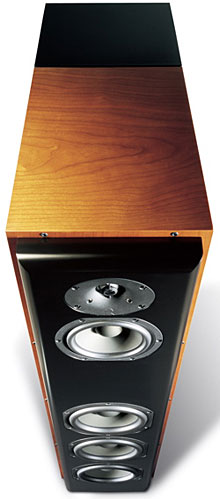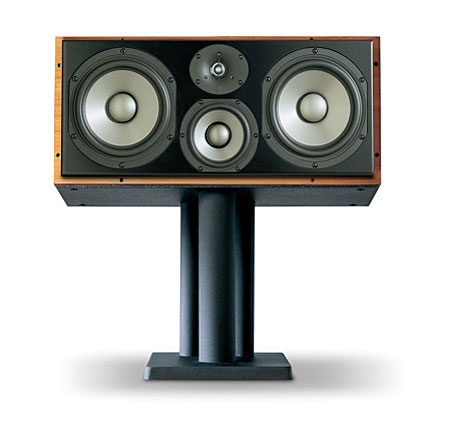Revel Performa F52 Speaker System
 Now Revel has refreshed that system, headlined by the new F52 floor standers and C52 center channel. While the Performa series may be one step down from Ultima in the Revel hierarchy, these two new models arguably represent the company's latest thinking in speaker technology. (The current Ultima line, now essentially unchanged for seven or more years apart from a new subwoofer, is scheduled for a complete redesign late this year or early in 2007.)
Now Revel has refreshed that system, headlined by the new F52 floor standers and C52 center channel. While the Performa series may be one step down from Ultima in the Revel hierarchy, these two new models arguably represent the company's latest thinking in speaker technology. (The current Ultima line, now essentially unchanged for seven or more years apart from a new subwoofer, is scheduled for a complete redesign late this year or early in 2007.)
Note that the price of the complete Performa system reviewed here will be $14,494 as of August 1, 2006—$2 more than the current price. The individual prices shown in the specifications reflect the August changes. While the M22s (used here for surrounds) and B15a (subwoofer) come down in price on July 1 by a total of approximately $500, the F52 goes up from the current $6498 to $6998/pair. Those in the market for just the F52s need to be aware of that.
Up Close and Personal
The new F52 and C52 look very much like the original F50 system on a cursory inspection, but there's more here than meets the eye.
Look closely at the new designs and you'll spot the most obvious change: a custom-designed, Controlled Acoustic Impedance (C.A.I.) waveguide surrounding the tweeter diaphragm. A similar but not identical waveguide was first used by Revel in the Concerta F12 system, reviewed by Michael Fremer back in December 2005). The function of the waveguide is to smooth the transition to the midrange at the tweeter's bottom end, particularly off-axis to optimize the first reflections and power response. The new tweeter is also vented to the rear to lower its fundamental resonance frequency, allowing a lower crossover frequency to further optimize the tweeter-midrange transition.
The F52 uses the same driver configuration as the F50, but like the tweeter, the midranges and woofers are also new. Updates to the magnetic structures, including aluminum and copper flux stabilization rings, are said to reduce distortion and improve heat dissipation and power handling. The cone material, as in the F50, is an organic ceramic-composite material. But the process and recipe are new.
The crossovers have been completely redesigned to complement the new drivers. As in the F50, the steep-slope high- and low-pass filter networks for the woofers, midrange, and tweeter are on separate circuit boards to prevent interference between the network components. As with all Revel Performa speakers, a design reference standard sample is retained for each model, and according to Revel each production unit is individually tuned to remain within 0.5dB of that reference.
In all other respects the F52 continues the construction and operational features that are common to other Revel Performa speakers, past and present. The cabinet has heavy, 1" thick walls and extensive internal bracing. Rounded baffle edges minimize diffraction. Adjustable, locking spikes may be installed with either pointed or rounded ends protruding for use on either carpeted or hardwood/tile floors. Two sets of high quality binding posts provide for bi-wiring or, with the shorting straps, for single wiring (which is how I used them). There are also two frequency compensation controls (more on this in the following section, below).

The new design, with redesigned baskets for the cone drivers and a black baffle, gives the F52 a more unified, elegant appearance than the F50. This held even with the grilles removed, which as usual was my preferred mode of operation.
The F52's narrow cabinet is a bit less stable than I'd like. If you must move the speaker around by yourself (as I did, though Revel recommends against it), walk the cabinet across the floor slowly and carefully (with the spikes removed, of course!), tipping it as little as possible so that if it does slip its center of gravity will keep it upright. The wedge-shaped cabinet has both acoustic and stylistic benefits, but this shape, together with a smooth, slick finish, makes it hard to get a good grip on it and, at the same time, avoid putting a finger through one of the drivers!
Staying Centered
The C52 uses two 8" woofers together with the same midrange, and tweeter as the F52, but here arranged in a horizontally configured center channel design.
Horizontally arranged drivers are prone to interference affects in the horizontal plane that affect the frequency response at seating positions to the left and right of center. This results in sharp valleys in the frequency response that are often centered directly in the presence region, reducing speech intelligibility.
These "suckouts" may be eliminated or greatly reduced a three-way design in which a separate midrange and tweeter are oriented vertically and flanked by two woofers, one on each side. This essentially eliminates the lateral interference between the midrange and tweeter. Interference is minimized between the midrange and woofers, and between the two displaced woofers themselves, by using a suitably low crossover between the midrange and woofers.
Revel is one of a handful of speaker manufacturers that employs such an optimum, three-way, center channel configuration in all of its center channel designs, including the C52.
Apart from its physical configuration, the C52 center channel uses the same technologies found in the F52, including the same cone material, tweeter waveguide, redesigned split-board crossover filters, dual binding posts, and solid, well-braced cabinet. At a hefty 41 pounds, with grille, it's also better suited for mounting on a stand under a projection screen than atop a big-screen TV—which may offer little or no top surface suitable for holding a center channel speaker, much less one that weighs this much.
Frequency Compensation
Following long-established Revel practice, both the C52 and F52 include two frequency contour controls. The Tweeter Level control is identical in both models and provides 0.5dB steps from -1dB to +1dB.
The other control is called Low Frequency Compensation in the F52 and Placement Compensation in the C52. In the F52 this control may be set to Normal for a speaker position at least 3' from any wall, Boundary if the speaker is built into a cabinet or is 2' or less from a wall, or Contour, which reduces low frequency levels. In the C52, the options are Flush Mounted for use in a bookcase or wall unit, On Top of Monitor, and Stand Mounted.
In my setup I set the F52's LF compensation to Normal and the C52's Placement Compensation control to On Top of Monitor. I actually had the C52 on a low stand under the screen, but at less than 18" from the floor that setting served a function similar to a boundary setting, reducing the slightly chesty quality that a near floor position can produce.
I settled on a Tweeter Level control setting of +0.5dB for both the F52 and C52. The control's 0.5dB steps may appear to be too small on paper to make any real difference, but the changes were clearly audible in critical listening.
- Log in or register to post comments




































































